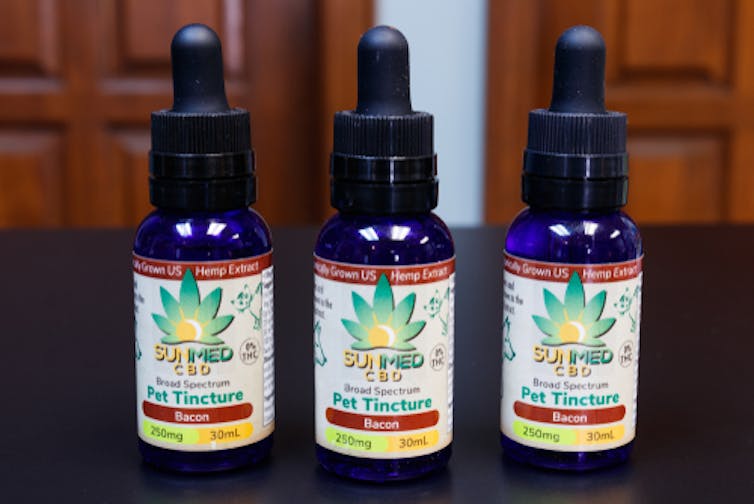Your pet on pot, or even CBD: Not a good thing, a vet toxicologist explains
As marijuana and its derivatives are sold legally in more states, pets are getting into pot, accidentally. And some owners are intentionally giving them CBD. A vet explains the dangers.

My family and I were on vacation in Florida recently and took advantage of a free afternoon to do some gift shopping for local memorabilia – not your ordinary T-shirts and key chains. Our adventure took us to St. Armand’s Key, part of Sarasota, and the many unique shops there.
While meandering between shops around the outdoor circle, my daughter, 14, was often quick to ask the locals, “Can I pet your dog?” She was missing her dog, Belle, who was being boarded back home and thought it would be a good idea to get her something too.
In our efforts to find Belle a gift, we stumbled upon the most unlikely of shops – a store that proudly advertised CBD (cannabidiol) for you and your pets. CBD is a chemical derived from the cannabis plant, but it does not contain THC, the chemical in pot that makes people high. Nonetheless, CBD appears to be the molecule of the moment after the Food and Drug Administration approved a drug in June 2018 that contains a CBD derivative to treat some forms of epilepsy.
Now, in all honesty, I was quite hesitant to make my way in, but there were quite a few dogs and their owners entering and exiting with various products – not all appearing to be CBD-related. So, I looked at my wife and said, “Why not?”
As a board-certified toxicologist at a major veterinary diagnostic laboratory, I have had experience working with a broad spectrum of poisoning incidents in all types of animals, including our companions. Recently, our lab has seen an increase in the number of positive tests for marijuana in dogs, many of whom may have accidentally ingested edible forms of marijuana. The American Society for the Prevention of Cruelty to Animals has reported a more than 700 percent increase in calls related to marijuana to its poison center in 2019.
As a dad and as a toxicologist, I welcomed the idea of answering my daughter’s questions about CBD and other chemicals in marijuana that are making their way to our pets. But, of course, I had to start with providing her with some context.
‘Why would people give it to their pets?’

Several items caught my daughter’s attention and, of course, she chuckled with amusement. In that moment, though, she began to ask some great questions: “What is CBD and hemp, and why would people give it to their pets?”
I first reminded her of the most recent election. In 2018, we saw the number of states that legalized marijuana for medical and recreational use expand to 33, including our home state, Michigan. Because of this legalization, there was also a marked expansion in the quantity and types of marijuana-related products available to people and pets, including hemp and CBD oils and pet treats.
So, what is the difference and significance of these products? Marijuana – also known as Cannabis sativa – is comprised of somewhere between 66 and 113 different cannabinoid compounds. Of these, recreational use of marijuana is sought after for the psychotropic “high” produced by delta-9-tetrahydrocannabinol, or THC. Humans either smoke marijuana or convert it into butters or oils for baked products – most notable of these are the often joked about “brownies” – or other edibles such as candy, or they may use the oil itself.
These edible formulations are more problematic for our household companion animals as these are more likely to contain higher concentrations of THC. And, they often include other ingredients that may independently cause harm to your pet such as chocolate, sugar and xylitol, a sugar substitute.
We have received cases at the veterinary diagnostic laboratory in which animals have been either inadvertently or intentionally exposed to marijuana products.
THC is known to be toxic to dogs. According to the Merck Veterinary Manual, common signs of marijuana toxicosis that owners may notice include inactivity; incoordination; dilated pupils; increased sensitivity to motion, sound or touch; hypersalivation; and urinary incontinence. A veterinary exam can reveal depression of the central nervous system and an abnormally slow heart rate. Less common signs include restlessness, aggression, slow breathing, low blood pressure, an abnormally fast heart rate, and rapid, involuntary eye movements. In rare cases, animals can have seizures or become comatose.
Hemp differs from marijuana in that it has a significantly lower THC content with predominantly more CBD. In a sense, this lessens the chances that an individual or pet will experience the negative side effects of THC, as CBD doesn’t exert the same psychoactive potential. However, there are no regulations on the chemical makeup of hemp products and therefore no way of really knowing, apart from relying on manufacturers’ labels for batch-to-batch variability in THC content. Additionally, very little is known regarding the long-term health effects of chronic exposure to these products, or about their use in conjunction with other medications.
Last, many CBD oils have claims of even higher purity than hemp. Similarly, though, these products are not regulated and therefore may still exhibit variability in chemical makeup. Additionally, many of the claims about cannabinoids’ effectiveness are anecdotal and have not yet been scientifically proven. This means that doctors of humans and animals remain somewhat skeptical about the potential benefits to their patients.
Why you shouldn’t give pot to your pets
So, why do people give these products to their pets?
For marijuana itself, my answer to my daughter was blunt. It is simply ignorance, or an abusive behavior that spawns from negligence. There are no good reasons to give your pet a “high” regardless of whether the product is legal for human medical or recreational purposes.
Pets are not people. Many prescription and over the counter drugs as well as foods that are safe for humans are not safe for pets. For example, alcohol is also toxic to pets and while some owners may think it’s funny to let their pets drink their beer or liquor, it can in fact be quite dangerous for the animal.
As for hemp and CBD oils – as a toxicologist, I am skeptical at best.
It is difficult to watch our pets suffer through anxiety or pain from ailments such as cancer. However, although these products have been touted for their therapeutic potential, none of them have gone through the rigor of an FDA approval. Anecdotal findings and limited case studies in humans do not constitute the wealth of information that is needed to establish these products as “safe” for our pets.
For people, there is an inclination to deem products that originate from plants as being “natural,” and thus rather arbitrarily “safe.” This, too, can be harmful. Simply put, “natural” does not always equal “safe.”
There is something to be said about the doctor-patient relationship in treating the whole patient – this goes for pets and their veterinarians as well. When we choose to use supplements, this needs to be disclosed to a licensed professional so as to allow for conversations about risks and continued health monitoring. It is not wise to bypass our trained professionals for the ill-trained Dr. Google.
As I continue to see more of these products show up in veterinary diagnostic samples, our interpretations will continually be guided by future scientific studies and case-based outcomes. Hopefully, a fuller understanding of these products and their associated benefits and risks will be had.
As for Belle – we purchased her a brightly colored new collar.

John P. Buchweitz does not work for, consult, own shares in or receive funding from any company or organisation that would benefit from this article, and has disclosed no relevant affiliations beyond their academic appointment.
Read These Next
What’s at stake in Trump’s executive order aiming to curb state-level AI regulation
In the absence of comprehensive federal AI regulation, states have stepped in. The Trump administration,…
Sleep problems and depression can be a vicious cycle, especially during pregnancy − here’s why it’s
Inadequate sleep can have negative downstream effects on everyday cognitive functioning and mental health,…
Whether Netflix or Paramount buys Warner Bros., entertainment oligopolies are back – bigger and mor
Hollywood has seen this movie before.





